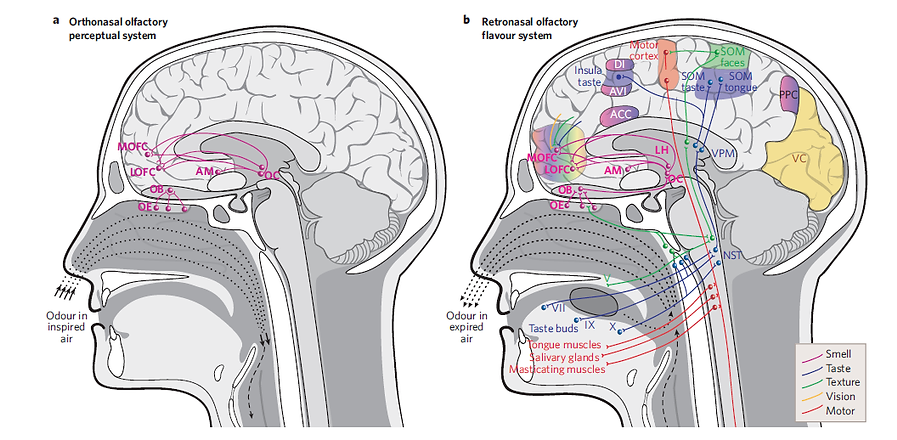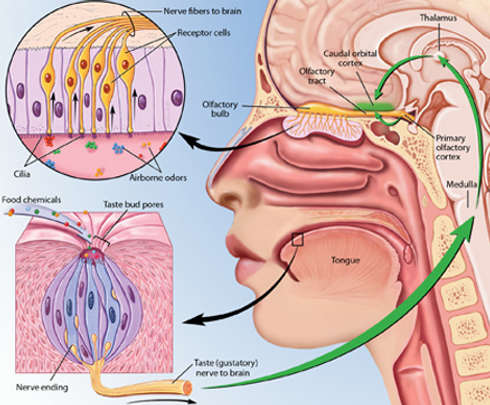OUR SENSE OF SMELL:
IT'S MORE IMPORTANT THAN WE THINK
The Perception of Flavor
According to Society for Neuroscience, the sense of taste and smell help us interpret the chemical world. These chemicals are in the air and in our food. Our sense of taste and smell are closely related in how we perceive flavors of food and without this dual interaction, our perception of food would be different.
Taste itself only involves chemicals that perceive foods that are sweet, salty, sour, and bitter. Taste buds on the tongue, the back of the mouth, and on the palate help us detect chemicals in our food. Everyone has around 5,000 to 10,000 taste buds and each taste bud has about 50 to 100 sensory cells. Sensory cells are stimulated and transferred to the ends of nerve fibers, which are sent to the cranial nerves and then to the brainstem. The impulses are then sent to the thalamus and to the specific parts of the cerebral cortex. Then, we have a perception of taste.
Airborne air molecules called odorants are detected by neurons in the mucus that lines the roof of the nose. Each odorant has its own pattern of activity. These patterns of activity are sent to the olfactory bulb, where neurons are stimulated to form a spatial map of an odor. Neural activity passes to the primary olfactory cortex or the oribtal cortex. Information then passes to adjacent parts of the orbital cortex and this is the region where odor and taste combine. The perception of flavor is then created.

According to Shepherd (2006), smell plays a dominant role in sensing flavors of the foods we choose to eat. Unfortunately, most people do not recognize the importance of the role between smell and flavor. Smell aids in the perception of flavor and this leads to a formation of cognitive and emotional responses to food as well as beverages. He expresses that since our diet is causing a public health crisis in many western countries, increasing our knowledge about the important role of smell can possibly help improve health conditions as well as prevent chronic conditions such as obesity and diabetes.
Even though the visual and auditory sensory systems do not contribute to flavor perception, these systems are involved in food identification, choice, and appreciation (Beauchamp & Mennella, 2011).
Most people believe that vision and hearing are the most important senses for humans and are usually devastated to lose one of these abilities later on in life. However, we do not realize how important it is to lose the sense of taste. It is rare for someone to lose all three sensory systems at the same time, but nutrition is compromised for those who do (typically following radiation therapy for head and neck cancer). Even though the loss of taste may not be as devastating as the loss of vision or hearing, our diet can be affected which can lead to major health problems (Beauchamp & Mennella, 2011).
What we normally think of as taste is actually more complex than we think. The sensation we experience comes together from information received about odor, temperature, texture, consistency, and from our taste buds. This sensation is called flavor and its characteristics reflect olfactory sensations from stimulations that occur in the mouth (Chifala & Polzella, 1995).
Small and Prescott (2005) explain that there have been studies of olfaction, taste, and flavor that include neuroimaging of the brain. These studies are beginning to isolate a network of regions that are likely responsible for flavor perception. Taste-odor integrations occur at earlier stages of processing compared to audio-visual integration. With this being said, it is possible that the early integration may be due to the fact that taste perception is almost always paired with taste and smell.
